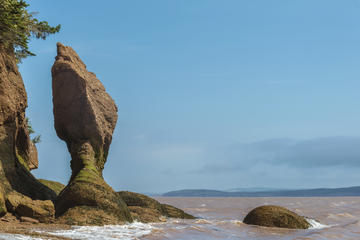Bay of Fundy
TIME : 2016/2/22 10:06:17

Bay of Fundy
You’ll have to visit the Bay of Fundy twice to truly see what the fuss is about — its beauty, home to the world’s most dramatic tidal fluctuations, lies in contrasts. The giant 170-mile-long saltwater bay, sandwiched by sections of Canadian provinces Nova Scotia and New Brunswick, has just the right shape and depth to create a natural sloshing and funnel motion to amplify tides, ensuring a constantly changing inshore landscape.
In Joggins, Nova Scotia, in the bay’s upper reaches, “vertical tides” can see the sea drop 50 feet or more in a matter of hours — the erosion caused by the tides constantly exposes different 300-million-year-old fossils, which have earned the area a UNESCO World Heritage designation. In other locales, including Alma, St Martins and Dorchester Cape (New Brunswick), extreme low tides uncover and envelop up to three miles of seafloor twice daily. In summer, exposed flats become host to tens of thousands of migratory birds that feed on sea creatures.
Adventurous visitors who want to experience Fundy’s power firsthand will enjoy boat and rafting rides on tidal bore rapids — sections along the bay where inflowing rivers go to battle with outflowing tides. The clash leaves regular waves of 10 to 12 feet ripe for riding.
The shoreline along the mouth of the bay where the world’s highest tides occur features dozens of lookouts, hiking trails and scenic drives. Two high and two low tides regularly occur in each 24-hour period, with about six hours and 15 minutes between each high and low tide. Before heading out, check the high/low tide times for locations throughout the bay; these times are also useful in predicting when tidal bore rapids will be present. Several tours explore the surrounding area by bus, but most visitors choose a lookout or hiking location along the bay, or hop on a whale-watching tour toward the mouth to watch for seabirds, dolphins and whales in the Atlantic.
Practical Info
Water-based tours runs seasonally, usually June through October.
